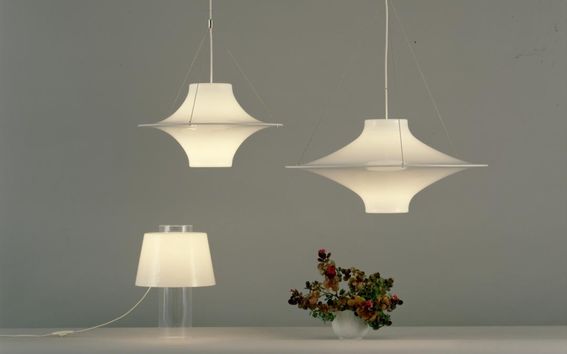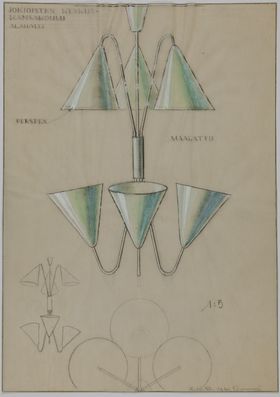Yki Nummi archive

The archive of Yki Nummi consist of biography and correspondence, as well as activity documents regarding colour and coloring, lightning and light fixtures, plastic items, and book illustrations. In addition, the collection includes lectures and presentations, on form and interior design, sketches, study-time works, wallpaper designs and magazine articles. The scope of the collection is 13 units. Some of the light fixture sketches and book illustration covers are available in digital form.
Artist Yki Nummi
Yrjö Kalevi Yrjönpoika Nummi was born in 31.10.1925 at the region of Hunan in China to a Finnish missionary family. Better known nickname” Yki” was adopted early on, by a need to distinguish two Yrjö’s – father and son – from each other. The parents were hoping that their first born would be a girl and the name had been thought accordingly. In a playful letter from a perspective of Yki the father writers: “Just as a joke had father always when someone mentioned the possibility of a boy, said that then it’s without question “Yrjö Yrjönpoika,” (Yrjö’s son). And then when I after all was a boy, father mused that what is decided is decided.” The family moved to Finland early on and Yki never mastered the Chinese language. However, the influence of the East was later to be seen in the artists own décor and partly in his work. The first inspiration for the artistic lifestyle Yki received from his childhood home. The mother Ida was a skillful pianist and the father Yrjö a keen drawer. Later born brothers – Lassi and Seppo – grew up to be respected artists in their chosen fields – Lassi in literature and Seppo in composition art.
Already at birth had Yki Nummi heard the turmoil of war in China, where the imperial regime had met its end in turn creating a power vacuum filled with competing forces. The next time the noises of battle reached his ears was in continuation war. In a letter to his mom dated 29.04.1944 Yki writes: “All is well. There was newly a small alarm – some russki pilot wants to get killed. Be well.” In the card is a drawing of a spruce filled landscape.


Entering design profession by accident
After military service Yki headed to study mathematics and physics but had a change of heart and instead ended, via the discipline of art history and drawing facility of Helsinki University, to University of Art and design to take up a degree in decorative painting. After graduation he was instantly hired as a lighting designer for the factory of Stockmann-Orno. In an interview in 1955 Nummi states that he ended up in the designing field by an error:
“As a matter of fact it happened as an error. I was just about to Finnish my decorative painting studies at Ateneum with an intend to become a painter. But then the architect Arttu Brummer came and took me to the Stockmann department store and that’s the road I’ve happily stayed on.”
Employed by Orno, Yki Nummi operated from 1950 to 1975, during which time he designed, among other things, the iconic Modern Art and Seagull -light fixtures. At the same time working at Orno were other notable designers of the time, such as Lisa Johansson-Pape as well as Svea Winkler.
Yki NummiFrom a rosy morning until a deep purple evening, colour guides life.
Light, colour and form
Yki Nummi understood that the post war period was favorable to the evolution of industrial art. Post-war reconstruction and population growth increased demand and increasing commercialization and urbanization accelerated the market. In lieu of personalized and handmade decorative products, Finland recovering from heavy war years longed for quickly made, simple and cheap products. Yki Nummi was at the frontline of this “design revolution” as a spokesperson for modernism. According to him the end goal of design was a product healthy in aesthetic, technical and commercial terms.Price increasing and efficiency lowering decorativeness gave way to simplified forms such as spheres, cones, and cylinders.
In his design Yki Nummi favored acrylic plastic for it was easy to shape material with excellent light conducting properties – hence perfect for feeding the artist’s passion for colours and their relations with light and shape. In his articles and lectures Yki Nummi analyzed the properties of different colours and the usability of them in interior design. The tone of the articles was often scientific but from time to time the artistic side of the designer also slipped in a few lively sentences such as: “a sophisticated sense of colour doesn't need such brutal orgies of colour”. Yki Nummi’s sense of colour has been responsible for the coloring of various known Finnish buildings and neighborhoods. During his tenure as a color expert at Tikkurila he guided Finns in creating a color scheme for their homes and was involved in the designing of the Joker -colour map. During the restoration of the Helsinki cathedral in the 1960s, the Helsinki Cathedral was painted in a light blue-grey hue in accordance with the artist's vision.
For Yki Nummi, colours were not simply colours for they had a holistic sense on life. “From a rosy morning until a deep purple evening, colour guides life. It has an effect on appetite, health, mood and moral. It fascinates, it’s repulsive, it attracts to buy, it scares away. It bleeds into everything, it’s everywhere, and it’s nothing, absolutely nothing, you can do to avoid its frantic embrace. Therefore, you’d better make peace with it and use it for your own purposes."
The digital archive collection
Illustrator of book covers
The design of Yki Nummi was not limited to light fixtures alone. Plans for a rowing boat, electric grill and radio receiver also emerged from the artist's pen. In the 1960s Nummi proposed three drafts for a font to the Church of Kuusjärvi. His lesser-known merits also include illustrations for several book covers. Yki Nummi's art can be seen especially in his brother Lassi Nummi’s poetry books, but already during his studies had he designed cover art for other works as well.
Creating the image of Finland
From early on the design of Yki Nummi garnered international attention. At the Milano Triennials in 1954 and 1957, his work was awarded by gold Medals. Especially in Japan Finnish design rose to a high esteem. The artist himself linked the success of Finnish design in some degree to cultural factors. According to him the honesty peculiar to Finns transmitted into the simplicity of the design. This honesty was something that Yki Nummi himself lived by. During one of his speeches in Osaka, Japan, the artist directly stated that he is unfortunately unable to answer to the question presented to him in advance, for as an honest man he must confess that he knows nothing about the said subject.

Rest of Yki Nummi's life was colored by an illness, which forced him to withdraw from work under the age of sixty and cost him his life eleven years later. However, he never abandoned art and during his retirement continued for example, to illustrate books. Nummi's influence to Finnish design is indisputable but his legacy to cultural history is perhaps even larger. Yki Nummi promoted the spread of the ideas of modernism both in Finland and in the world. With his international prominence he elevated the national self esteem of a country recovering from war. The artist's design language has retained its timelessness, and, for example, the Seagull lamp is still being manufactured.
Text: Laura Kalliokuusi
- Published:
- Updated:



